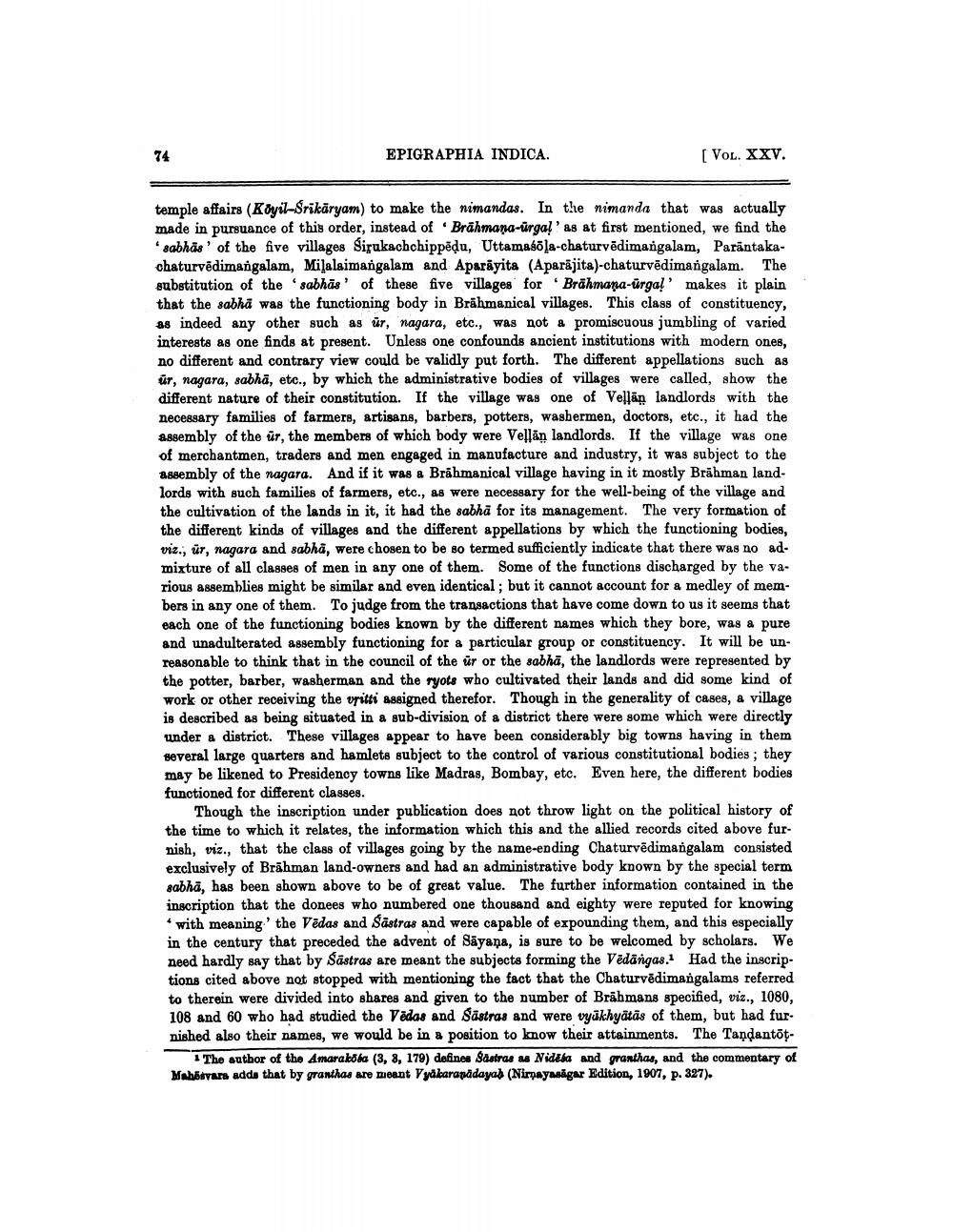________________
EPIGRAPHIA INDICA.
[VOL. XXV.
temple affairs (Koyil-Srikäryam) to make the nimandas. In the nimanda that was actually made in pursuance of this order, instead of Brahmana-ūrgal'as at first mentioned, we find the
sabhäs' of the five villages Sirukachchippēdu, Uttamasõla-chaturvēdimangalam, Parāntakachaturvēdimangalam, Milalaimangalam and Aparāyita (Aparājita)-chaturvēdimangalam. The substitution of the 'sabhās' of these five villages for Brāhmaṇa-ūrgal' makes it plain that the sabha was the functioning body in Brāhmanical villages. This class of constituency, as indeed any other such as ür, nagara, etc., was not a promiscuous jumbling of varied interests as one finds at present. Unless one confounds ancient institutions with modern ones, no different and contrary view could be validly put forth. The different appellations such as úr, nagara, sabha, etc., by which the administrative bodies of villages were called, show the different nature of their constitution. If the village was one of Vellän landlords with the necessary families of farmers, artisans, barbers, potters, washermen, doctors, etc., it had the assembly of the ür, the members of which body were Vellan landlords. If the village was one of merchantmen, traders and men engaged in manufacture and industry, it was subject to the assembly of the nagara. And if it was a Brāhmanical village having in it mostly Brāhman landlords with such families of farmers, etc., 88 were necessary for the well-being of the village and the cultivation of the lands in it, it had the sabhā for its management. The very formation of the different kinds of villages and the different appellations by which the functioning bodies, viz., ür, nagara and sabha, were chosen to be so termed sufficiently indicate that there was no admixture of all classes of men in any one of them. Some of the functions discharged by the various assemblies might be similar and even identical; but it cannot account for a medley of members in any one of them. To judge from the transactions that have come down to us it seems that each one of the functioning bodies known by the different names which they bore, was a pure and unadulterated assembly functioning for a particular group or constituency. It will be unreasonable to think that in the council of the ur or the sabha, the landlords were represented by the potter, barber, washerman and the ryots who cultivated their lands and did some kind of work or other receiving the voitti assigned therefor. Though in the generality of cases, a village is described as being situated in a sub-division of a district there were some which were directly under a district. These villages appear to have been considerably big towns having in them Beveral large quarters and hamlets subject to the control of various constitutional bodies; they may be likened to Presidency towns like Madras, Bombay, etc. Even here, the different bodies functioned for different classes.
Though the inscription under publication does not throw light on the political history of the time to which it relates, the information which this and the allied records cited above furnish, viz., that the class of villages going by the name-ending Chaturvēdimangalam consisted exclusively of Brāhman land-owners and had an administrative body known by the special term sabha, has been shown above to be of great value. The further information contained in the inscription that the donees who numbered one thousand and eighty were reputed for knowing * with meaning the Vēdas and Šāstras and were capable of expounding them, and this especially in the century that preceded the advent of Sāyana, is sure to be welcomed by scholars. We need hardly say that by Sāstras are meant the subjects forming the Vēdāngas. Had the inscriptions cited above not stopped with mentioning the fact that the Chaturvēdimangalams referred to therein were divided into shares and given to the number of Brahmans specified, viz., 1080, 108 and 60 who had studied the Vedas and Sastras and were vyūkhyätäs of them, but had fur. nished also their names, we would be in a position to know their attainments. The Taņdantot
The author of the Amarakba (3, 8, 179) defines Sastras as Nidela and granthas, and the commentary of Mahodyars adds that by granthas are meant Vyakararādayal (Nirnayasagar Edition, 1907, p. 327).




